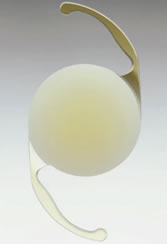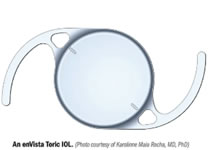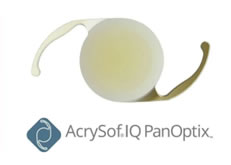Cataract
Inside everyone’s eye is a lens. Just like with a camera, the lens of your eye helps you to focus on things whether they are nearby or far away. To work well, the lens must be clear. As you age, the lens of your eye gradually becomes cloudy. We call a cloudy lens a cataract. The word cataract comes from an old Latin word for waterfall. Waterfalls produce heavy mist that can blur your vision. Cataracts have the same effect—blurry vision. Looking through a cloudy lens is like looking through a dirty window—everything is blurred.
Everyone who lives into their 60s develops at least mild cataracts. Early on, the cataract process not only makes your lens cloudy, it also makes your lens swell a little bit. When your lens gets bigger, you become a little more near-sighted. So in the early stages of cataract, simply changing your glasses prescription will usually restore your sight.
But as you continue to get older, the cataract gets more and more cloudy, and eventually not even a change in your glasses prescription will improve your sight. At that point, the only way to restore your vision is to remove the cataract.
What is a Cataract & What is the Treatment?
Cataract Surgery
Cataract surgery is the most common surgical procedure performed on adults in the United States .In fact, cataract surgery is one of the most successful surgical procedure performed today -about 95% of all cataract surgeries result in an improvement of vision. The procedure is performed on an outpatient basis, generally, takes a half-hour or less, and recovery time is usually only a few days.
Cataract surgery is a two-step procedure—first the surgeon removes your cloudy lens, and second, a new lens implant is inserted into your eye. The cloudy lens is removed with a tiny instrument that enters your eye through a small incision—usually one-eighth of an inch or smaller—and gently breaks the cataract into tiny pieces that are then removed from the eye with a miniature vacuum cleaner.
Once the cataract is out, you will need a new lens in order to focus after surgery. Artificial lens implants—made of silicone or acrylic materials—are used to restore your ability to focus after surgery. These implants come in many different strengths, like glasses, and before your cataract operation, we will perform several measurements to determine the appropriate lens implant strength for your eye.
Once your cataract is out and your implant is in, the operation is over. Most people see better within a day or two after cataract surgery, but it is not abnormal or worrisome if your vision seems blurry for a few weeks after surgery as your eye heals. We will prescribe some eye drops for the healing period after surgery, and if you need new glasses after surgery, these will be prescribed for you once your eye is completely healed, usually about a month after surgery.
Cataracts cannot grow back, but sometimes a thin cloudy membrane grows behind the lens implant, making your vision blurry like the cataract did. This is not uncommon—it happens to roughly 40 percent of patients having cataract surgery. If it happens to you, a quick and simple laser treatment can be performed in the office to make a hole in the membrane for you to see through.
Lens Implants
There are three types of implant a patient can choose from: Monofocal, Toric and Multifocal lenses.

These lenses allow for the correction of near or farsightedness but do not correct astigmatism.

These lenses will correct astigmatism as well as near and far sightness.

These are recommended for patients who would like to decrease the need for glasses for distance and for near. They also correct astigmatism.
One example is the Panoptic lens. This lens has concentric circles which divide the incoming light so that 50% is dedicated to distance,25% for intermediate and 25% to near. This lens can not be used for patients with significant macular disease.
